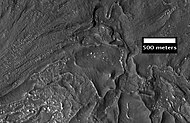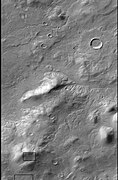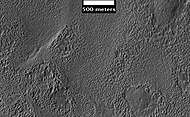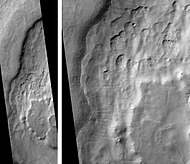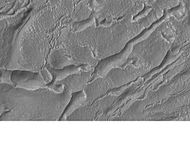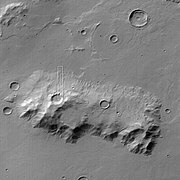Hellas quadrangle
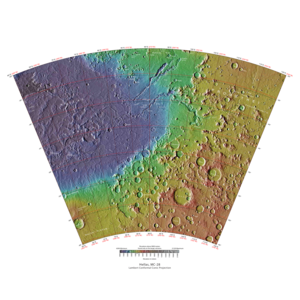 Map of Hellas quadrangle from Mars Orbiter Laser Altimeter (MOLA) data. The highest elevations are red and the lowest are blue. | |
| Coordinates | 47°30′S 270°00′W / 47.5°S 270°W / -47.5; -270Coordinates: 47°30′S 270°00′W / 47.5°S 270°W / -47.5; -270 |
|---|---|

Image of the Hellas Quadrangle (MC-28). The northwestern part contains the eastern half of Hellas basin. The southwest part includes Amphitrites volcano. The northern part contains Hadriaca Patera. The eastern part is mainly heavily cratered highlands.
The Hellas quadrangle is one of a series of 30 quadrangle maps of Mars used by the United States Geological Survey (USGS) Astrogeology Research Program. The Hellas quadrangle is also referred to as MC-28 (Mars Chart-28).[1]
The Hellas quadrangle covers the area from 240° to 300° west longitude and 30° to 65° south latitude on the planet Mars. Within the Hellas quadrangle lies the classic features Hellas Planitia and Promethei Terra. Many interesting and mysterious features have been discovered in the Hellas quadrangle, including the giant river valleys Dao Vallis, Niger Vallis, Harmakhis, and Reull Vallis—all of which may have contributed water to a lake in the Hellas basin in the distant past.[2][3][4] Many places in the Hellas quadrangle show signs of ice in the ground, especially places with glacier-like flow features.
Contents
1 Hellas Basin
2 Lobate debris aprons
3 Lineated Floor Deposits
4 Ice-rich mantle
5 Upper Plains Unit
6 Climate change caused ice-rich features
7 Origin of Dao Vallis
8 Dust devil tracks
9 Evidence for possible recent liquid water
10 Other Craters
11 Glacial Features
12 Channels
13 Layers
14 Honeycomb terrain
15 Gullies
16 Polygons
17 Exposed ice sheets
18 Scalloped topography
19 Pits
20 Additional Images in Hellas quadrangle
21 Other Mars quadrangles
22 Interactive Mars map
23 See also
24 References
25 External links
Hellas Basin
The Hellas quadrangle contains part of the Hellas Basin, the largest known impact crater on the surface of Mars and the second largest in the solar system. The depth of the crater is 7152 m[5] (23,000 ft) below the standard topographic datum of Mars. The basin is located in the southern highlands of Mars and is thought to have been formed about 3.9 billion years ago, during the Late Heavy Bombardment. Studies suggest that when an impact created the Hellas Basin, the entire surface of Mars was heated hundreds of degrees, 70 meters of molted rock fell on the planet, and an atmosphere of gaseous rock was formed. This rock atmosphere was 10 times as thick as the Earth's atmosphere. In a few days, the rock would have condensed out and covered the whole planet with an additional 10 m of molten rock.[2] In the Northwest portion of Hellas Planitia is a strange type of surface called complex banded terrain or taffy-pull terrain. Its process of formation is still largely unknown, although it appears to be due to erosion of hard and soft sediment along with ductile deformation. Ductile deformation results from layers undergoing strain.[6]
Early in the planet's history, it is believed that a giant lake existed in the Hellas Basin.[7] Possible shorelines have been discovered. These are evident in alternating benches and scarps visible in Mars orbiting camera narrow-angle images. In addition, Mars orbiting laser altimeter (MOLA) data show that the contacts of these sedimentary units mark contours of constant elevation for thousands of km, and in one case all around the basin. Channels, believed to be formed by water, enter into the basin. The Hellas drainage basin may be almost one-fifth that of the entire northern plains. A lake in Hellas in today's Martian climate would form a thick ice at the top that would eventually sublimate away. That is the ice would turn directly from a solid to a gas. This is similar to how dry ice (solid carbon dioxide) behaves on Earth.[3] Glacial features (terminal moraines, drumlins, and eskers) have been found that may have been formed when the water froze.[2][8]
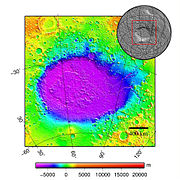
Hellas Basin Area topography. Crater depth is 7152 m[5] (23,000 ft) below the standard topographic datum of Mars.

Hellas Basin with graph showing the great depth of the crater. It is the deepest crater on Mars and has the highest surface pressure: 1155 Pa[5] (11.55 mbar, 0.17 psi, or 0.01 atm).

Twisted Ground in Hellas, as seen by HiRISE This is one more example of how difficult it would be to walk on Mars.
Lobate debris aprons
One very important feature common in east Hellas are piles of material surrounding cliffs. The formation is called a lobate debris apron (LDA). Recently, research with the Shallow Radar on the Mars Reconnaissance Orbiter has provided strong evidence that the LDAs are glaciers that are covered with a thin layer of rocks.[9][10][11][12][13] Large amounts of water ice are believed to be in the LDAs. Available evidence strongly suggests that the eastern part of Hellas accumulated snow in the past. When the tilt (obliquity) of Mars increases the southern ice cap releases large amounts of water vapor. Climate models predict that when this occurs, water vapor condenses and falls where LDAs are located. The tilt of the earth changes little because our relatively large moon keeps it stable. The two tiny Martian moons do not stabilize their planet, so the rotational axis of Mars undergoes large variations.[14] Lobate debris aprons may be a major source of water for future Mars colonists. Their major advantage over other sources of Martian water are that they can easily mapped from orbit and they are closer to the equator, where manned missions are more likely to land.

Close-up of surface of a lobate debris apron. Note the lines that are common in rock glaciers on the Earth. Image located in Hellas quadrangle.
CTX Context image for next two images of debris apron around mound.
Surface of Debris Apron. There is also a feature similar to features in Red Rocks Park Colorado. Feature seems to be composed of slanted rock layers. Image taken with HiRISE, under the HiWish program.

Surface of debris apron in Terra Cimmeria, as seen by HiRISE, under the HiWish program. Colored parts may be frost deposits.
Lineated Floor Deposits
On the floors of some channels are features called lineated floor deposits or lineated valley fill. They are ridged and grooved materials that seem to deflect around obstacles. They are believed to be ice-rich. Some glaciers on the Earth show such features. Lineated floor deposits may be related to lobate debris aprons, which have been proven to contain large amounts of ice. Reull Vallis, as pictured below, displays these deposits.[15]
Drainage features in Reull Vallis, as seen by THEMIS. Click on image to see relationship of Reull Vallis to other features.

Reull Vallis with lineated floor deposits, as seen by THEMIS. Click on image to see relationship to other features.

Lineated valley fill, as seen by HiRISE under HiWish program

Reull Vallis floor showing lineated valley fill at the top and hollows near bottom, as seen by HiRISE under HiWish program

Close, color view of lineated valley fill, as seen by HiRISE under HiWish program
Layers in Reull Vallis, as seen by THEMIS.

Fretted terrain near Reull Vallis, as seen by HiRISE.
Close-up of Fretted Terrain near Reull Vallis, as seen by HiRISE. This area would be a challenge to walk across.

Layers in Monument Valley. These are accepted as being formed, at least in part, by water deposition. Since Mars contains similar layers, water remains as a major cause of layering on Mars.
Ice-rich mantle
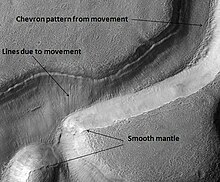
Niger Vallis with features typical of this latitude, as seen by HiRISE. Chevron patterns result from movement of ice-rich material. Click on image to see chevron pattern and mantle
Much of the surface of Mars is covered by a thick smooth mantle that is thought to be a mixture of ice and dust. This ice-rich mantle, a few yards thick, smoothes the land, but in places it displays a bumpy texture, resembling the surface of a basketball. Because there are few craters on this mantle, the mantle is relatively young. The image at the right shows a good view of this smooth mantle around Niger Vallis, as observed with HiRISE.
Changes in Mars's orbit and tilt cause significant changes in the distribution of water ice from polar regions down to latitudes equivalent to Texas. During certain climate periods water vapor leaves polar ice and enters the atmosphere. The water returns to the ground at lower latitudes as deposits of frost or snow mixed generously with dust. The atmosphere of Mars contains a great deal of fine dust particles. Water vapor condenses on the particles, then they fall down to the ground due to the additional weight of the water coating. When ice at the top of the mantling layer goes back into the atmosphere, it leaves behind dust, which insulates the remaining ice.[16]

Smooth mantle with layers, as seen by HiRISE under HiWish program

Close view of mantle, as seen by HiRISE under HiWish program

Crater showing how thick mantle is in place, as seen by HiRISE under the HiWish program

Close view of the edge of mantle, as seen by HiRISE under the HiWish program
Upper Plains Unit
Remnants of a 50-100 meter thick mantling, called the upper plains unit, has been discovered in the mid-latitudes of Mars. First investigated in the Deuteronilus Mensae region, but it occurs in other places as well. The remnants consist of sets of dipping layers in craters and along mesas.[17] Sets of dipping layers may be of various sizes and shapes—some look like Aztec pyramids from Central America.
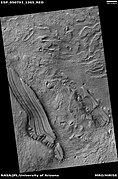
Tilted layers, as seen by HiRISE under HiWish program

Tilted layers, as seen by HiRISE under HiWish program

Tilted layers, as seen by HiRISE under HiWish program

Layered feature probably formed by the erosion of the upper plains unit, as seen by HiRISE under HiWish program.

Layered feature in Red Rocks Park, Colorado. This has a different origin than ones on Mars, but it has a similar shape. Features in Red Rocks region were caused by uplift of mountains.

Layered feature that is probably the remains of a once widespread unit that fell from the sky, as seen by HiRISE under the HiWish program

Layered feature, as seen by HiRISE under the HiWish program

Layered feature in crater, as seen by HiRISE under the HiWish program

Layered feature in crater, as seen by HiRISE under the HiWish program

Layers in crater, as seen by HiRISE under HiWish program

Layered feature in crater, as seen by HiRISE under HiWish program

Layered feature in crater, as seen by HiRISE under HiWish program
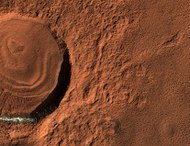
Close, color view of layered feature in crater, as seen by HiRISE under HiWish program Different colors are due to different minerals.

Layered structure in crater that is probably what is left of a layered unit that once covered a much larger area. Material for this unit fell from the sky as ice-coated dust. The picture was taken by HiRISE, under the HiWish program.
This unit also degrades into brain terrain. Brain terrain is a region of maze-like ridges 3–5 meters high. Some ridges may consist of an ice core, so they may be sources of water for future colonists.

Wide view of upper plains unit breaking down into brain terrain, as seen by HiRISE under HiWish program

Close view of upper plains unit breaking down into brain terrain, as seen by HiRISE under HiWish program As ice leaves the ground, the ground collapses and winds blow the remaining dust away.

Small, layered structure, as seen by HiRISE under the HiWish program Picture also shows brain terrain forming.
Some regions of the upper plains unit display large fractures and troughs with raised rims; such regions are called ribbed upper plains. Fractures are believed to have started with small cracks from stresses. Stress is suggested to initiate the fracture process since ribbed upper plains are common when debris aprons come together or near the edge of debris aprons—such sites would generate compressional stresses. Cracks exposed more surfaces, and consequently more ice in the material sublimates into the planet's thin atmosphere. Eventually, small cracks become large canyons or troughs. Small cracks often contain small pits and chains of pits; these are thought to be from sublimation of ice in the ground.[18][19]
Large areas of the Martian surface are loaded with ice that is protected by a meters thick layer of dust and other material. However, if cracks appear, a fresh surface will expose ice to the thin atmosphere.[20][21] In a short time, the ice will disappear into the cold, thin atmosphere in a process called sublimation. Dry ice behaves in a similar fashion on the Earth. On Mars sublimation has been observed when the Phoenix lander uncovered chunks of ice that disappeared in a few days.[22][23] In addition, HiRISE has seen fresh craters with ice at the bottom. After a time, HiRISE saw the ice deposit disappear.[24]

Die-sized clumps of bright material in the enlarged "Dodo-Goldilocks" trench vanished over the course of four days, implying that they were composed of ice which sublimated following exposure.[23][25]

Color versions of the photos showing ice sublimation, with the lower left corner of the trench enlarged in the insets in the upper right of the images.
The upper plains unit is thought to have fallen from the sky. It drapes various surfaces, as if it fell evenly. As is the case for other mantle deposits, the upper plains unit has layers, is fine-grained, and is ice-rich. It is widespread; it does not seem to have a point source. The surface appearance of some regions of Mars is due to how this unit has degraded. It is a major cause of the surface appearance of lobate debris aprons.[19]
The layering of the upper plains mantling unit and other mantling units are believed to be caused by major changes in the planet's climate. Models predict that the obliquity or tilt of the rotational axis has varied from its present 25 degrees to maybe over 80 degrees over geological time. Periods of high tilt will cause the ice in the polar caps to be redistributed and change the amount of dust in the atmosphere.[26][27][28]
Climate change caused ice-rich features
Many features on Mars, including ones in Hellas quadrangle, are believed to contain large amounts of ice. The most popular model for the origin of the ice is climate change from large changes in the tilt of the planet's rotational axis. At times the tilt has even been greater than 80 degrees[29][30] Large changes in the tilt explains many ice-rich features on Mars.
Studies have shown that when the tilt of Mars reaches 45 degrees from its current 25 degrees, ice is no longer stable at the poles.[31] Furthermore, at this high tilt, stores of solid carbon dioxide (dry ice) sublimate, thereby increasing the atmospheric pressure. This increased pressure allows more dust to be held in the atmosphere. Moisture in the atmosphere will fall as snow or as ice frozen onto dust grains. Calculations suggest this material will concentrate in the mid-latitudes.[32][33] General circulation models of the Martian atmosphere predict accumulations of ice-rich dust in the same areas where ice-rich features are found.[30]
When the tilt begins to return to lower values, the ice sublimates (turns directly to a gas) and leaves behind a lag of dust.[34][34][35] The lag deposit caps the underlying material so with each cycle of high tilt levels, some ice-rich mantle remains behind.[36] Note, that the smooth surface mantle layer probably represents only relative recent material.
Origin of Dao Vallis

Dao Vallis, as seen by THEMIS. Click on image to see relationship of Dao Vallis to other nearby features
Dao Vallis begins near a large volcano, called Hadriaca Patera, so it is thought to have received water when hot magma melted huge amounts of ice in the frozen ground.[2] The partially circular depressions on the left side of the channel in the adjacent image suggests that groundwater sapping also contributed water.[37]
Dust devil tracks

Secchi Crater Floor, as seen by HiRISE. Click on image to see dust devil tracks and a pedestal crater
Many areas on Mars, including the Hellas quadrangle, experience the passage of giant dust devils. A thin coating of fine bright dust covers most of the martian surface. When a dust devil goes by it blows away the coating and exposes the underlying dark surface. Dust devils have been seen from the ground and from orbiting spacecraft. They have even blown the dust off of the solar panels of the two Rovers on Mars, thereby greatly extending their lives.[38] The twin Rovers were designed to last for 3 months, instead they have lasted more than five years and are still going. The pattern of the tracks have been shown to change every few months.[39] A study that combined data from the High Resolution Stereo Camera (HRSC) and the Mars Orbiter Camera (MOC) found that some large dust devils on Mars have a diameter of 700 meters and last at least 26 minutes.[40]

Dust devil tracks on floor of Wallace Crater, as seen by CTX camera (on Mars Reconnaissance Orbiter)

Dust devil tracks, as seen by HiRISE under HIWish program

Dust devil tracks and boulders, as seen by HiRISE under HIWish program
Evidence for possible recent liquid water

Penticton Crater New Light-Toned Feature, as seen by HiRISE
The Mars Reconnaissance Orbiter discovered changes on the wall of Penticton Crater between 1999 and 2004. One interpretation of the changes was that they were caused by water flowing on the surface.[41] A further analysis, published about a year later, revealed that the deposit could have been caused by gravity moving material down slope (a landslide). The slope where the deposit was sighted was close to the stability limits of dry, unconsolidated materials.[42]
Other Craters
Impact craters generally have a rim with ejecta around them, in contrast volcanic craters usually do not have a rim or ejecta deposits. As craters get larger (greater than 10 km in diameter) they usually have a central peak.[43] The peak is caused by a rebound of the crater floor following the impact.[44] Sometimes craters will display layers. Craters can show us what lies deep under the surface.

Pedestal crater, as seen by HiRISE under HiWish program

Pedestal craters form when the ejecta from impacts protect the underlying material from erosion. As a result of this process, craters appear perched above their surroundings.

Drawing shows a later idea of how some pedestal craters form. In this way of thinking, an impacting projectile goes into an ice-rich layer—but no further. Heat and wind from the impact hardens the surface against erosion. This hardening can be accomplished by the melting of ice which produces a salt/mineral solution thereby cementing the surface.

Pedestal craters, as seen by HiRISE under HiWish program
Stair-stepping mesas in interior deposit of Spallanzani Crater, as seen by THEMIS

Side view of crater that was cut by a wall, as seen by HiRISE under HiWish program Other craters are also in this view.
Penticton Crater gullies, as seen by HiRISE

Lipik Crater Channels, as seen by THEMIS

Tikhov Crater, as seen by CTX camera (on Mars Reconnaissance Orbiter)

Floor of Wallace Crater, as seen by CTX camera (on Mars Reconnaissance Orbiter)

Dust devil tracks on floor of Wallace Crater, as seen by CTX camera (on Mars Reconnaissance Orbiter). Note this is an enlargement of the previous image of the floor of Wallace Crater.

Huxley Crater, as seen by CTX camera (on Mars Reconnaissance Orbiter)

Gledhill Crater, as seen by CTX camera (on Mars Reconnaissance Orbiter)

Redi Crater, as seen by CTX camera (on Mars Reconnaissance Orbiter)

Redi Crater, showing dust devil tracks and mantle, as seen by CTX camera (on Mars Reconnaissance Orbiter). Note: this is an enlargement of the previous image of Redi Crater.
Glacial Features
Glaciers, loosely defined as patches of currently or recently flowing ice, are thought to be present across large but restricted areas of the modern Martian surface, and are inferred to have been more widely distributed at times in the past.[45][46] Lobate convex features on the surface known as viscous flow features and lobate debris aprons, which show the characteristics of non-Newtonian flow, are now almost unanimously regarded as true glaciers.[45][47][48][49][50][51][52][53][54]
A climate model, reported in the journal Science in 2006, found that large amounts of ice should accumulate in the Hellas region, in the same places where glaciers are observed. Water is transported from the south polar area to northern Hellas and falls as precipitation.[55]

Flows, as seen by HiRISE under HiWish program

Close, color view of flow, as seen by HiRISE under HIWish program
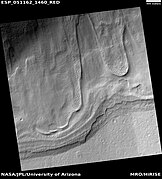
Flows, as seen by HiRISE under HiWish program

Flow, as seen by HiRISE under HiWish program

Close, color view of flow, as seen by HiRISE under HiWish program Patterned ground is visible in the photo.

Flow, as seen by HiRISE under HiWish program Flows, as seen by HiRISE under HiWish program

Flow, as seen by HiRISE under HiWish program

Flow, as seen by HiRISE under HiWish program

Flow, as seen by HiRISE under HiWish program

Close view of snout of flow, as seen by HiRISE under HiWish program Polygonal patterned ground is visible.

Wide view of tongue-shaped glaciers, as seen by HiRISE under HiWish program

Close view of tongue-shaped glaciers, as seen by HiRISE under HiWish program Polygons are visible.
Surface features that show down hill movement, as seen by HiRISE.
CTX context image of Hellas Planitia showing location of next two images.
Surface in Hellas quadrangle, as seen by HiRISE, under the HiWish program.
Possible Glacial Cirque in Hellas Planitia, as seen by HiRISE, under the HiWish program. Lines are probably due to downhill movement.

Romer Lake's Elephant Foot Glacier in the Earth's Arctic, as seen by Landsat 8. This picture shows several glaciers that have the same shape as many features on Mars that are believed to also be glaciers.

Flow feature that was probably a glacier, as seen by HiRISE under HiWish program

Flow ridges, as seen by HiRISE under the HiWish program Ridges probably formed at the end of old glacier.

Context for the next image of the end of a flow feature or glacier. Location is Hellas quadrangle.
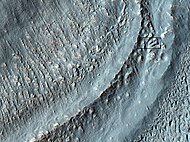
Close-up of the area in the box in the previous image. This may be called by some the terminal moraine of a glacier. For scale, the box shows the approximate size of a football field. Image taken with HiRISE under the HiWish program. Location is Hellas quadrangle.
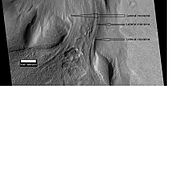
Material Flowing through a crater rim, as seen by HiRISE, under the HiWish program. Lateral moraines are labeled.

Glaciers, as seen by HiRISE, under HiWish program. Glacier on left is thin because it has lost much of its ice. Glacier on the right, on the other hand, is thick; it still contains a lot of ice that is under a thin layer of dirt and rock.

Tongue-shaped glacier, as seen by HiRISE under the HiWish program. Ice may exist in the glacier, even today, beneath an insulating layer of dirt.

Close-up of tongue-shaped glacier, as seen by HiRISE under the HiWish program Resolution is about 1 meter, so one can see objects a few meters across in this image. Ice may exist in the glacier, even today, beneath an insulating layer of dirt.

Tongue-shaped glaciers indicated with arrows, as seen by HiRISE under the HiWish program

Close view of snout of glacier, as seen by HiRISE under the HiWish program High center polygons are visible. Box shows size of football field.

Close view of high center polygons near glacier, as seen by HiRISE under the HiWish program

Close view of high center polygons near glacier, as seen by HiRISE under the HiWish program

Close view of high center polygons near glacier, as seen by HiRISE under the HiWish program Box shows size of football field.

Close view of high center polygons near glacier, as seen by HiRISE under the HiWish program

Tongue-shaped glacier, as seen by HiRISE under the HiWish program

Wide view of tongue-shaped flows, as seen by HiRISE under the HiWish program

Close view of tongue-shaped flows, as seen by HiRISE under the HiWish program

Close view of tongue-shaped flows and polygonal terrain (which is labeled), as seen by HiRISE under the HiWish program

Close view of polygonal terrain near tongue-shaped flows, as seen by HiRISE under the HiWish program

Grooves caused by movement of glacier, as seen by HiRISE under HiWish program

Close, color view of polygons, as seen by HiRISE under HiWish program Polygons are common in ice-rich ground.
Channels
There is enormous evidence that water once flowed in river valleys on Mars.[56][57] Images of curved channels have been seen in images from Mars spacecraft dating back to the early seventies with the Mariner 9 orbiter.[58][59][60][61] Indeed, a study published in June 2017, calculated that the volume of water needed to carve all the channels on Mars was even larger than the proposed ocean that the planet may have had. Water was probably recycled many times from the ocean to rainfall around Mars.[62][63]
Mad Vallis, as seen by HiRISE. Picture on right is an enlargement of part of the other picture.

Channels, as seen by HiRISE under HiWish program.

Streamlined shape in old river valley, as seen by HiRISE under HiWish program. The streamlined shape is evidence of running water.

Channel, as seen by HiRISE under HiWish program

Channel, as seen by HiRISE under HiWish program

Channels, as seen by HiRISE under HiWish program

Wide view of small channels, as seen by HiRISE under HiWish program

Close view of channels, as seen by HiRISE under HiWish program

Channel network, as seen by HiRISE under HiWish program
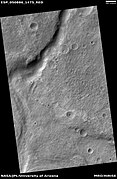
Valley, as seen by HiRISE under HiWish program

Channel, as seen by HiRISE under HiWish program Arrows indicate evidence of a meander.

Close view of small channels that seem to originate in a mantle layer, as seen by HiRISE under HiWish program

Channels, as seen by HiRISE under the HiWish program
Layers
Many places on Mars show rocks arranged in layers. Rock can form layers in a variety of ways. Volcanoes, wind, or water can produce layers.[64]
A detailed discussion of layering with many Martian examples can be found in Sedimentary Geology of Mars.[65]

Layers, as seen by HiRISE under HiWish program

Layers, as seen by HiRISE under HiWish program

Close view of layers, as seen by HiRISE under HiWish program Boulders are also visible in the image.

Wide view of layers, as seen by HiRISE under HiWish program

Close view of layered deposit in crater, as seen by HiRISE under HiWish program

Close view of layers, as seen by HiRISE under HiWish program

Layered formation, as seen by HiRISE under HiWish program

Close view of layers from previous image, as seen by HiRISE under HiWish program

Layers, as seen by HiRISE under HiWish program

Wide view of layers, as seen by HiRISE under HiWish program

Channel of a gully indicated with arrows Picture enlarged from previous image

Close view of layers, as seen by HiRISE under HiWish program

Wide view of layers, as seen by HiRISE under HiWish program

Close view of layers, as seen by HiRISE under HiWish program

Close view of layers, as seen by HiRISE under HiWish program Some of the layers are breaking up into large blocks

Close view of layers, as seen by HiRISE under HiWish program Some of the layers are breaking up into large blocks

Layers, as seen by HiRISE under HiWish program
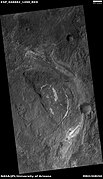
Layers, as seen by HiRISE under HiWish program Some layers are light-toned which means that they may have been associated with water.

Close view of layers, as seen by HiRISE under HiWish program Some layers are light-toned which means that they may have been associated with water.

Close view of light-toned materials, as seen by HiRISE under HiWish program Light-toned materials have been associated with water.

Wide view of light and dark toned layers, as seen by HiRISE under HiWish program

Close view of light and dark toned layers, as seen by HiRISE under HiWish program

Close view of light and dark toned layers, as seen by HiRISE under HiWish program

Close, color view of layers, as seen by HiRISE under HiWish program The different colors represent different minerals.

Wide view of light and dark toned layers, as seen by HiRISE under HiWish program

Close, color view of layers, as seen by HiRISE under HiWish program The different colors represent different minerals.

Close, color view of layers, as seen by HiRISE under HiWish program

Wide view of layers in mounds, as seen by HiRISE under HiWish program

Close view of layers in mound, as seen by HiRISE under HiWish program
Honeycomb terrain
These relatively flat-lying “cells” appear to have concentric layers or bands, similar to a honeycomb. This “honeycomb” terrain was first discovered in the northwestern part of Hellas.[66] The geologic process responsible for creating these features remains unresolved.[67] Some calculations indicate that this formation may have been caused by ice moving up through the ground in this region. The ice layer would have been between 100 m and 1 km thick.[68][69][66] When one substance moves up through another denser substance, it is called a diapir. So, it seems that large masses of ice have pushed up layers of rock into domes that were eroded. After erosion removed the top of the layered domes, circular features remained.
Diapirs are thought to be responsible for features on Neptune's moon Triton, Jupiter's moon Europa, Saturn's moon Enceladus, and Uranus's moon Miranda.[70]

Concentric bands and layers that has been called "honeycomb terrain" Picture was taken by HiRISE under the HiWish program.
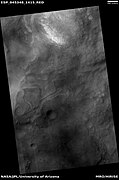
Circular layers, as seen by HiRISE under HiWish program

layers and ridges that form strange patterns, as seen by HiRISE under HiWish program

Close view of ridges forming strange patterns, as seen by HiRISE under HiWish program

Honeycomb terrain, as seen by HiRISE under HiWish program

Close, color view of honeycomb terrain, as seen by HiRISE under HiWish program

Close view of honeycomb terrain, as seen by HiRISE under HiWish program

Close view of honeycomb terrain, as seen by HiRISE under HiWish program This enlargement shows material breaking up into blocks. Arrow indicates a cube-shaped block.

Ridges, as seen by HiRISE under HiWish program

Close view of concentric and parallel ridges, as seen by HiRISE under HiWish program

Wide view of ridge network, as seen by HiRISE under HiWish program

Close view of ridge network, as seen by HiRISE under HiWish program

Close view of ridge network, as seen by HiRISE under HiWish program
Gullies
Gullies occur on steep slopes, especially on the walls of craters. Gullies are believed to be relatively young because they have few, if any craters. Moreover, they lie on top of sand dunes which themselves are considered to be quite young. Usually, each gully has an alcove, channel, and apron. Some studies have found that gullies occur on slopes that face all directions,[71] others have found that the greater number of gullies are found on poleward facing slopes, especially from 30-44 S.[72]
For years, many believed that gullies were formed by running water, but further observations demonstrate that they may be formed by dry ice. Recent studies describe using the High Resolution Imaging Science Experiment (HiRISE) camera on MRO to examine gullies at 356 sites, starting in 2006. Thirty-eight of the sites showed active gully formation. Before-and-after images demonstrated the timing of this activity coincided with seasonal carbon dioxide frost and temperatures that would not have allowed for liquid water. When dry ice frost changes to a gas, it may lubricate dry material to flow especially on steep slopes.[73][74][75] In some years frost, perhaps as thick as 1 meter, triggers avalanches. This frost contains mostly dry ice, but also has tiny amounts of water ice.[76]

Gullies in crater, as seen by HiRISE under HiWish program

Close view of gullies in crater, as seen by HiRISE under HiWish program Polygons are visible in this close view.
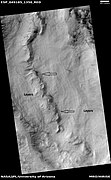
Wide view of layers and gullies, as seen by HiRISE under HiWish program Arrows point to small gullies.

Close view of small gully, as seen by HiRISE under HiWish program

Wide view of gullies, as seen by HiRISE under HiWish program

Close, color view of gullies, as seen by HiRISE under HiWish program

Close view of gullies, as seen by HiRISE under HiWish program Curves in channels are evidence that these gullies were not created by landslides.
Polygons
Some surfaces on Mars display polygons. These may be of different sizes. Polygons are an example of patterned ground. Polygonal, patterned ground is quite common in some regions of Mars.[77][78][79][80][81][82][83]

Group of polygons, as seen by HiRISE under HiWish program

Patterned ground in Hellas, as seen by HiRISE under HiWish program The rectangle shows the size of a football field.
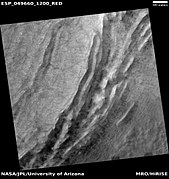
Wide view of polygons, as seen by HiRISE under HiWish program Parts of this image are enlarged in following images.

Polygons, as seen by HiRISE under HiWish program

Close view of polygons, as seen by HiRISE under HiWish program Arrow point to boulders that sit inside of small craters.

Close view of polygons, as seen by HiRISE under HiWish program

Close view of polygons, as seen by HiRISE under HiWish program
Exposed ice sheets
Thick deposits of ice were found by a team of researchers using instruments on board the Mars Reconnaissance Orbiter (MRO).[84] The scientists found eight eroding slopes showing exposed water ice sheets as thick as 100 meters. Seven of the locations were in the southern hemisphere. Much evidence of buried ice under the ground on vast regions of Mars has already been found by past studies, but this study found that the ice was only covered by a layer of about 1 or 2 meters thick of soil.[85][86][87] Shane Byrne of the University of Arizona Lunar and Planetary Laboratory, Tucson, one of the co-authors remarked that future colonists of the Red Planet would be able to gather up ice with just a bucket and shovel.[88]
The layered ice is exposed in triangular shaped depressions. One wall is very steep and faces the pole. The fact that water-ice makes up the layers was confirmed by Compact Reconnaissance Imaging Spectrometer for Mars (CRISM) on board the Mars Reconnaissance Orbiter (MRO). The spectra gathered by CRISM showed strong signals of water.[89] The layers are especially prominent in depressions in Hellas quadrangle as shown in the enlarged views below.
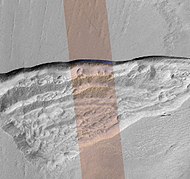
Wide view of triangular depression, as seen by HiRISE The colored strip shows the part of the image that can be seen in color. The wall at the top of the depression contains pure ice. This wall faces the south pole. Location is Hellas quadrangle.[90]

Close, color view of wall containing ice from previous image, as seen by HiRISE

Wide view of triangular depression, as seen by HiRISE The wall which faces the south pole contains ice in distinct layers that are visible in next image. Location is Hellas quadrangle.[91]

Close view of wall of triangular depression, as seen by HiRISE layers are visible in the wall. The lower layers are tilted, while layers near the surface are more or less horizontal. Such an arrangement of layers is called an "angular unconformity."[92]

Wide view of triangular depression, as seen by HiRISE The wall which faces the south pole contains ice in distinct layers that are visible in next image. Location is Hellas quadrangle.[93]

Close view of wall of triangular depression, as seen by HiRISE layers are visible in the wall. The lower layers are tilted, while layers near the surface are more or less horizontal. Such an arrangement of layers is called an "angular unconformity."
Besides being of great value to future explorers, these ice layers could help us better understand the climate history of Mars. They provide a record of the past. The large variations in the tilt of the planet cause dramatic climate variations. Mars does not possess a large moon to keep its tilt stable. Today, ice is concentrated at the poles, with a greater tilt, more ice will exist at mid-latitudes.
These climate changes may be able to be measured with study of these layers.
These triangular depressions are similar to those in scalloped terrain. However scalloped terrain, displays a gentle equator-facing slope and is rounded.
Scalloped topography
Scalloped topography is common in the mid-latitudes of Mars, between 45° and 60° north and south. It is particularly prominent in the region of Utopia Planitia,[94][95] in the northern hemisphere, and in the region of Peneus and Amphitrites Paterae[96][97] in the southern hemisphere. Such topography consists of shallow, rimless depressions with scalloped edges, commonly referred to as "scalloped depressions" or simply "scallops". Scalloped depressions can be isolated or clustered and sometimes seem to coalesce. A typical scalloped depression displays a gentle equator-facing slope and a steeper pole-facing scarp.[98] Scalloped depressions are believed to form from the removal of subsurface material, possibly interstitial ice, by sublimation (direct transition of a material from the solid to the gas phase with no intermediate liquid stage). This process may still be happening at present.[99] This topography may be of great importance for future colonization of Mars because it may point to deposits of pure ice.[100]

Stages in scalop formation, as seen by HiRISE. These formations probably form from the sublimation of ground rich in pure water ice many meters in depth.[101]

Scalloped terrain, as seen by HiRISE under HIWish program Dust devil tracks are also visible.
Pits
Some places on Mars display pits. It is believed that a void was created and material collapsed into the pits. These pits are probably most commonly formed when ice leaves the ground thereby creating a void. In the thin atmosphere of Mars, ice will sublimate, especially if a crack occurs. Sublimation is when a solid turns directly into a gas. Dry ice does this on the Earth. Some pits are associated with cracks in the surface.[102][103][104][105][106]

Wide view of pits, as seen by HiRISE under HIWish program

Close view of pits, as seen by HiRISE under HIWish program The box shows the size of the pits. Some pits are as wide as a football field is long.

Wide view of pits and dust devil tracks, as seen by HiRISE under HiWish program

Close view of pits as seen by HiRISE under HiWish program Box shows size of football field. Pits in image may be around 10–20 meters across.

Pits, as seen by HiRISE under HIWish program
Additional Images in Hellas quadrangle
Hellas quadrangle map showing two large river valleys that slope left, toward the floor of the crater.

Field of hollows, as seen by HiRISE under HiWish program

Surface features, as seen by HiRISE under HiWish program

Hollows on floor of Reull Vallis, as seen by HiRISE under HiWish program
Banded or taffy-pull terrain in Hellas, as seen by Mars Global Surveyor. Origin is unknown at present.

Centauri Montes, as seen by HiRISE. Scale bar is 500 meters long. The original enlargement of the image at the left is full of rich detail on all parts of the picture.
Ausonia Mensa, as seen by MGS, under the MOC Public Targeting Program. This eroded mensa has many channels.

Stages in scalop formation, as seen by HiRISE. These formations probably form from the sublimation of ground rich in pure water ice many meters in depth.[101]

Possible dike and troughs, as seen by HiRISE under HiWish program The arrows point to the possible dike along the left edge of picture. Straight features are rare in nature; they are often due to dikes and joints.

Odd shapes, as seen by HiRISE under HiWish program part of this image is enlarged in next image.

Ridges forming from cracks, as seen by HiRISE under HiWish program Box in upper left shows size of football field.

Dunes, as seen by HiRISE under HiWish program

Wide view of brain terrain, as seen by HiRISE under HiWish program

Close, side view of brain terrain from previous image, as seen by HiRISE under HiWish program

Out of place rock, as seen by HiRISE under HiWish program The arrow points to a large rock that is definitely out of place. It may be a meteorite or it may have been tossed here by a nearby impact.

Close view of out of place rock, as seen by HiRISE under HiWish program It may be a meteorite or it may have been tossed here by a nearby impact.
Other Mars quadrangles
Interactive Mars map
See also
- Brain terrain
- Climate of Mars
- Diapir
- Dust devil tracks
- Geology of Mars
- Glacier
- Glaciers on Mars
- HiRISE
- HiWish program
- Impact crater
- Latitude dependent mantle
- Lakes on Mars
- Lineated valley fill
- List of quadrangles on Mars
- Lobate debris apron
- Martian Gullies
- Ore resources on Mars
- Pedestal crater
- Phoenix (spacecraft)
- Polygonal patterned ground
- Scalloped topography
- Upper Plains Unit
- Vallis
- Water on Mars
References
^ Davies, M.E.; Batson, R.M.; Wu, S.S.C. (1992). "Geodesy and Cartography". In Kieffer, H.H.; Jakosky, B.M.; Snyder, C.W.; et al. Mars. Tucson: University of Arizona Press. ISBN 978-0-8165-1257-7..mw-parser-output cite.citation{font-style:inherit}.mw-parser-output q{quotes:"""""""'""'"}.mw-parser-output code.cs1-code{color:inherit;background:inherit;border:inherit;padding:inherit}.mw-parser-output .cs1-lock-free a{background:url("//upload.wikimedia.org/wikipedia/commons/thumb/6/65/Lock-green.svg/9px-Lock-green.svg.png")no-repeat;background-position:right .1em center}.mw-parser-output .cs1-lock-limited a,.mw-parser-output .cs1-lock-registration a{background:url("//upload.wikimedia.org/wikipedia/commons/thumb/d/d6/Lock-gray-alt-2.svg/9px-Lock-gray-alt-2.svg.png")no-repeat;background-position:right .1em center}.mw-parser-output .cs1-lock-subscription a{background:url("//upload.wikimedia.org/wikipedia/commons/thumb/a/aa/Lock-red-alt-2.svg/9px-Lock-red-alt-2.svg.png")no-repeat;background-position:right .1em center}.mw-parser-output .cs1-subscription,.mw-parser-output .cs1-registration{color:#555}.mw-parser-output .cs1-subscription span,.mw-parser-output .cs1-registration span{border-bottom:1px dotted;cursor:help}.mw-parser-output .cs1-hidden-error{display:none;font-size:100%}.mw-parser-output .cs1-visible-error{font-size:100%}.mw-parser-output .cs1-subscription,.mw-parser-output .cs1-registration,.mw-parser-output .cs1-format{font-size:95%}.mw-parser-output .cs1-kern-left,.mw-parser-output .cs1-kern-wl-left{padding-left:0.2em}.mw-parser-output .cs1-kern-right,.mw-parser-output .cs1-kern-wl-right{padding-right:0.2em}
^ abcd Carr, Michael H. (2006). The Surface of Mars. Cambridge University Press. p. [page needed]. ISBN 978-0-521-87201-0.
^ ab Moore, J; Wilhelms, Don E. (2001). "Hellas as a possible site of ancient ice-covered lakes on Mars". Icarus. 154 (2): 258–276. Bibcode:2001Icar..154..258M. doi:10.1006/icar.2001.6736.
^ Cabrol, N. and E. Grim (eds). 2010. Lakes on Mars
^ abc Martian Weather Observation Archived 2008-05-31 at the Wayback Machine. MGS radio science measured 11.50 mbar at 34.4° S 59.6° E -7152 meters.
^ http://hirise.lpl.arizonai.edu/P/sP_008559_1405[permanent dead link]
^ Voelker, M., et al. 2016. DISTRIBUTION AND EVOLUTION OF LACUSTRINE AND FLUVIAL FEATURES IN HELLAS
PLANITIA, MARS, BASED ON PRELIMINARY RESULTS OF GRID-MAPPING. 47th Lunar and Planetary Science Conference (2016) 1228.pdf.
^ Kargel, J.; Strom, R. (1991). "Terrestrial glacial eskers: analogs for martian sinuous ridges" (PDF). LPSC. XXII: 683–684. Bibcode:1991LPI....22..683K.
^ Head, JW; Neukum, G; Jaumann, R; Hiesinger, H; Hauber, E; Carr, M; Masson, P; Foing, B; et al. (2005). "Tropical to mid-latitude snow and ice accumulation, flow and glaciation on Mars". Nature. 434 (7031): 346–350. Bibcode:2005Natur.434..346H. doi:10.1038/nature03359. PMID 15772652.
^ http://www.marstoday.com/news/viewpr.html?pid=18050[permanent dead link]
^ http://news.brown.edu/pressreleases/2008/04/martian-glaciers
^ Plaut, Jeffrey J.; Safaeinili, Ali; Holt, John W.; Phillips, Roger J.; Head, James W.; Seu, Roberto; Putzig, Nathaniel E.; Frigeri, Alessandro (2009). "Radar Evidence for Ice in Lobate Debris Aprons in the Mid-Northern Latitudes of Mars" (PDF). Geophysical Research Letters. 36 (2): n/a. Bibcode:2009GeoRL..3602203P. doi:10.1029/2008GL036379.
^ Holt, J.W.; Safaeinili, A.; Plaut, J. J.; Young, D. A.; Head, J. W.; Phillips, R. J.; Campbell, B. A.; Carter, L. M.; Gim, Y.; Seu, R.; Sharad Team (2008). "Radar Sounding Evidence for Ice within Lobate Debris Aprons near Hellas Basin, Mid-Southern Latitudes of Mars" (PDF). Lunar and Planetary Science. XXXIX: 2441. Bibcode:2008LPI....39.2441H.
^ Holt, J. W.; Safaeinili, A.; Plaut, J. J.; Head, J. W.; Phillips, R. J.; Seu, R.; Kempf, S. D.; Choudhary, P.; et al. (2008). "Radar Sounding Evidence for Buried Glaciers in the Southern Mid-Latitudes of Mars". Science. 322 (5905): 1235–8. Bibcode:2008Sci...322.1235H. doi:10.1126/science.1164246. PMID 19023078.
^ "Archived copy". Archived from the original on 2010-06-17. Retrieved 2010-12-19.CS1 maint: Archived copy as title (link)
^ MLA NASA/Jet Propulsion Laboratory (December 18, 2003). "Mars May Be Emerging From An Ice Age". ScienceDaily. Retrieved February 19, 2009.
^ Carr, M. 2001.
^ Morgenstern, A., et al. 2007
^ ab Baker, D., J. Head. 2015. Extensive Middle Amazonian mantling of debris aprons and plains in Deuteronilus Mensae, Mars: Implication for the record of mid-latitude glaciation. Icarus: 260, 269-288.
^ Mangold, N (2003). "Geomorphic analysis of lobate debris aprons on Mars at Mars Orbiter Camera scale: Evidence for ice sublimation initiated by fractures". J. Geophys. Res. 108: 8021. Bibcode:2003JGRE..108.8021M. doi:10.1029/2002je001885.
^ Levy, J. et al. 2009. Concentric
^ Bright Chunks at Phoenix Lander's Mars Site Must Have Been Ice – Official NASA press release (19.06.2008)
^ ab http://www.nasa.gov/mission_pages/phoenix/news/phoenix-20080619.html
^ Byrne, S. et al. 2009. Distribution of Mid-Latitude Ground Ice on Mars from New Impact Craters: 329.1674-1676
^ Smith, P., et al. 2009. H2O at the Phoenix Landing Site. Science: 325, 58-61.
^ Head, J. et al. 2003.
^ Madeleine, et al. 2014.
^ Schon; et al. (2009). "A recent ice age on Mars: Evidence for climate oscillations from regional layering in mid-latitude mantling deposits". Geophys. Res. Lett. 36: L15202. Bibcode:2009GeoRL..3615202S. doi:10.1029/2009gl038554.CS1 maint: Explicit use of et al. (link)
^ Touma, J.; Wisdom, J. (1993). "The Chaotic Obliquity of Mars". Science. 259: 1294–1297. Bibcode:1993Sci...259.1294T. doi:10.1126/science.259.5099.1294. PMID 17732249.
^ ab Laskar, J.; Correia, A.; Gastineau, M.; Joutel, F.; Levrard, B.; Robutel, P. (2004). "Long term evolution and chaotic diffusion of the insolation quantities of Mars". Icarus. 170: 343–364. Bibcode:2004Icar..170..343L. doi:10.1016/j.icarus.2004.04.005.
^ Levy, J.; Head, J.; Marchant, D.; Kowalewski, D. (2008). "Identification of sublimation-type thermal contraction crack polygons at the proposed NASA Phoenix landing site: Implications for substrate properties and climate-driven morphological evolution". Geophys. Res. Lett. 35. Bibcode:2008GeoRL..35.4202L. doi:10.1029/2007GL032813.
^ Levy, J.; Head, J.; Marchant, D. (2009). "Thermal contraction crack polygons on Mars: Classification, distribution, and climate implications from HiRISE observations". J. Geophys. Res. 114. Bibcode:2009JGRE..114.1007L. doi:10.1029/2008JE003273.
^ Hauber, E., D. Reiss, M. Ulrich, F. Preusker, F. Trauthan, M. Zanetti, H. Hiesinger, R. Jaumann, L. Johansson, A. Johnsson, S. Van Gaselt, M. Olvmo. 2011. Landscape evolution in Martian mid-latitude regions: insights from analogous periglacial landforms in Svalbard. In: Balme, M., A. Bargery, C. Gallagher, S. Guta (eds). Martian Geomorphology. Geological Society, London. Special Publications: 356. 111-131
^ ab Mellon, M.; Jakosky, B. (1995). "The distribution and behavior of Martian ground ice during past and present epochs". J. Geophys. Res. 100: 11781–11799. Bibcode:1995JGR...10011781M. doi:10.1029/95je01027.
^ Schorghofer, N (2007). "Dynamics of ice ages on Mars". Nature. 449: 192–194. Bibcode:2007Natur.449..192S. doi:10.1038/nature06082. PMID 17851518.
^ Madeleine, J., F. Forget, J. Head, B. Levrard, F. Montmessin. 2007. Exploring the northern mid-latitude glaciation with a general circulation model. In: Seventh International Conference on Mars. Abstract 3096.
^ http://themis.asu.edu/zoom-20020807a
^ http://marsrovers.jpl.nasa.gov/gallery/press/spirit/20070412a.html
^ "Archived copy". Archived from the original on 2011-10-28. Retrieved 2012-01-19.CS1 maint: Archived copy as title (link)
^ Reiss, D.; et al. (2011). "Multitemporal observations of identical active dust devils on Mars with High Resolution Stereo Camera (HRSC) and Mars Orbiter Camera (MOC)". Icarus. 215: 358–369. Bibcode:2011Icar..215..358R. doi:10.1016/j.icarus.2011.06.011.CS1 maint: Explicit use of et al. (link)
^ Malin, M. C.; Edgett, K. S.; Posiolova, L. V.; McColley, S. M.; Dobrea, E. Z. N. (2006). "Present-Day Impact Cratering Rate and Contemporary Gully Activity on Mars". Science. 314 (5805): 1573–1577. Bibcode:2006Sci...314.1573M. doi:10.1126/science.1135156. PMID 17158321.
^ McEwen, AS; Hansen, CJ; Delamere, WA; Eliason, EM; Herkenhoff, KE; Keszthelyi, L; Gulick, VC; Kirk, RL; et al. (2007). "A Closer Look at Water-Related Geologic Activity on Mars". Science. 317 (5845): 1706–1709. Bibcode:2007Sci...317.1706M. doi:10.1126/science.1143987. PMID 17885125.
^ http://www.lpi.usra.edu/publications/slidesets/stones/
^ Kieffer, Hugh H. (1992). Mars. Tucson: University of Arizona Press. pp. [, page , needed], . ISBN 0-8165-1257-4.
^ ab "The Surface of Mars" Series: Cambridge Planetary Science (No. 6)
ISBN 978-0-511-26688-1 Michael H. Carr, United States Geological Survey, Menlo Park
^ Hugh H. Kieffer (1992). Mars. University of Arizona Press. ISBN 978-0-8165-1257-7. Retrieved March 7, 2011.
^ Milliken, R. E.; Mustard, J. F.; Goldsby, D. L. (2003). "Viscous flow features on the surface of Mars: Observations from high-resolution Mars Orbiter Camera (MOC) images". Journal of Geophysical Research. 108 (E6): 5057. Bibcode:2003JGRE..108.5057M. doi:10.1029/2002je002005.
^ Squyres, S.W.; Carr, M.H. (1986). "Geomorphic evidence for the distribution of ground ice on Mars". Science. 213: 249–253. Bibcode:1986Sci...231..249S. doi:10.1126/science.231.4735.249.
^ Head, J.W.; Marchant, D.R.; Dickson, J.L.; Kress, A.M. (2010). "Criteria for the recognition of debris-covered glacier and valley glacier landsystem deposits". Earth Planet. Sci. Lett. 294: 306–320. Bibcode:2010E&PSL.294..306H. doi:10.1016/j.epsl.2009.06.041.
^ Holt, J.W.; et al. (2008). "Radar sounding evidence for buried glaciers in the southern mid-latitudes of Mars". Science. 322: 1235–1238. Bibcode:2008Sci...322.1235H. doi:10.1126/science.1164246. PMID 19023078.CS1 maint: Explicit use of et al. (link)
^ Morgan, G.A.; Head, J.W.; Marchant, D.R. (2009). "Lineated valley fill (LVF) and lobate debris aprons (LDA) in the Deuteronilus Mensae northern dichotomy boundary region, Mars: Constraints on the extent, age and episodicity of Amazonian glacial events". Icarus. 202: 22–38. Bibcode:2009Icar..202...22M. doi:10.1016/j.icarus.2009.02.017.
^ Plaut, J.J.; Safaeinili, A.; Holt, J.W.; Phillips, R.J.; Head, J.W.; Sue, R.; Putzig, A. (2009). "Frigeri Radar evidence for ice in lobate debris aprons in the mid-northern latitudes of Mars". Geophys. Res. Lett. 36: L02203. Bibcode:2009GeoRL..36.2203P. doi:10.1029/2008gl036379.
^ Baker, D.M.H.; Head, J.W.; Marchant, D.R. (2010). "Flow patterns of lobate debris aprons and lineated valley fill north of Ismeniae Fossae, Mars: Evidence for extensive mid-latitude glaciation in the Late Amazonian". Icarus. 207: 186–209. Bibcode:2010Icar..207..186B. doi:10.1016/j.icarus.2009.11.017.
^ Arfstrom, J. (2005). "Terrestrial analogs and interrelationships". Icarus. 174: 321–335. Bibcode:2005Icar..174..321A. doi:10.1016/j.icarus.2004.05.026.
^ Forget, F., et al. 2006. Formation of Glaciers on Mars by Atmospheric Precipitation at High Obliquity. Science: 311, 368-371.
^ Baker, V.; et al. (2015). "Fluvial geomorphology on Earth-like planetary surfaces: a review". Geomorphology. 245: 149–182. doi:10.1016/j.geomorph.2015.05.002.CS1 maint: Explicit use of et al. (link)
^ Carr, M. 1996. in Water on Mars. Oxford Univ. Press.
^ Baker, V. 1982. The Channels of Mars. Univ. of Tex. Press, Austin, TX
^ Baker, V.; Strom, R.; Gulick, V.; Kargel, J.; Komatsu, G.; Kale, V. (1991). "Ancient oceans, ice sheets and the hydrological cycle on Mars". Nature. 352: 589–594. Bibcode:1991Natur.352..589B. doi:10.1038/352589a0.
^ Carr, M (1979). "Formation of Martian flood features by release of water from confined aquifers". J. Geophys. Res. 84: 2995–300. Bibcode:1979JGR....84.2995C. doi:10.1029/jb084ib06p02995.
^ Komar, P (1979). "Comparisons of the hydraulics of water flows in Martian outflow channels with flows of similar scale on Earth". Icarus. 37: 156–181. Bibcode:1979Icar...37..156K. doi:10.1016/0019-1035(79)90123-4.
^ http://spaceref.com/mars/how-much-water-was-needed-to-carve-valleys-on-mars.html
^ Luo, W., et al. 2017. New Martian valley network volume estimate consistent with ancient ocean and warm and wet climate. Nature Communications 8. Article number: 15766 (2017). doi:10.1038/ncomms15766
^ "HiRISE | High Resolution Imaging Science Experiment". Hirise.lpl.arizona.edu?psp_008437_1750. Retrieved 2012-08-04.
^ Grotzinger, J. and R. Milliken (eds.). 2012. Sedimentary Geology of Mars. SEPM.
^ ab Bernhardt, H.; et al. (2016). "The honeycomb terrain on the Hellas basin floor, mars: a case for salt or ice diapirism: hellas honeycombs as salt/ice diapirs". J. Geophys. Res. 121: 714–738. Bibcode:2016JGRE..121..714B. doi:10.1002/2016je005007.CS1 maint: Explicit use of et al. (link)
^ http://www.uahirise.org/ESP_049330_1425
^ Weiss, D., J. Head. 2017. HYDROLOGY OF THE HELLAS BASIN AND THE EARLY MARS CLIMATE: WAS THE HONEYCOMB TERRAIN FORMED BY SALT OR ICE DIAPIRISM? Lunar and Planetary Science XLVIII. 1060.pdf
^ Weiss, D.; Head, J. (2017). "Salt or ice diapirism origin for the honeycomb terrain in Hellas basin, Mars?: Implications for the early martian climate". Icarus. 284: 249–263. Bibcode:2017Icar..284..249W. doi:10.1016/j.icarus.2016.11.016.
^ Cassini Imaging Central Laboratory for Operations, Enceladus Rev 80 Flyby: Aug 11 '08. Retrieved 2008-08-15.
^ Edgett, K.; Malin, M. C.; Williams, R. M. E.; Davis, S. D. (2003). "Polar-and middle-latitude martian gullies: A view from MGS MOC after 2 Mars years in the mapping orbit" (PDF). Lunar Planet. Sci. 34. p. 1038, Abstract 1038. Bibcode:2003LPI....34.1038E.
^ Dickson, J; Head, J; Kreslavsky, M (2007). "Martian gullies in the southern mid-latitudes of Mars: Evidence for climate-controlled formation of young fluvial features based upon local and global topography" (PDF). Icarus. 188 (2): 315–323. Bibcode:2007Icar..188..315D. doi:10.1016/j.icarus.2006.11.020.
^ http://www.jpl.nasa.gov/news/news.php?release=2014-226
^ http://hirise.lpl.arizona.edu/ESP_032078_1420
^ http://www.space.com/26534-mars-gullies-dry-ice.html
^ http://spaceref.com/mars/frosty-gullies-on-mars.html
^ http://www.diss.fu-berlin.de/diss/servlets/MCRFileNodeSe[permanent dead link] rvlet/FUDISS_derivate_000000003198/16_ColdClimateLandforms-13-utopia.pdf?hosts=
^ Kostama, V.-P.; Kreslavsky, M.; Head, J. (2006). "Recent high-latitude icy mantle in the northern plains of Mars: Characteristics and ages of emplacement". Geophys. Res. Lett. 33: L11201. Bibcode:2006GeoRL..3311201K. doi:10.1029/2006GL025946.
^ Malin, M.; Edgett, K. (2001). "Mars Global Surveyor Mars Orbiter Camera: Interplanetary cruise through primary mission". J. Geophys. Res. 106 (E10): 23429–23540. Bibcode:2001JGR...10623429M. doi:10.1029/2000je001455.
^ Milliken, R.; et al. (2003). "Viscous flow features on the surface of Mars: Observations from high-resolution Mars Orbiter Camera (MOC) images". J. Geophys. Res. 108. Bibcode:2003JGRE..108.5057M. doi:10.1029/2002JE002005.CS1 maint: Explicit use of et al. (link)
^ Mangold, N (2005). "High latitude patterned grounds on Mars: Classification, distribution and climatic control". Icarus. 174: 336–359. Bibcode:2005Icar..174..336M. doi:10.1016/j.icarus.2004.07.030.
^ Kreslavsky, M.; Head, J. (2000). "Kilometer-scale roughness on Mars: Results from MOLA data analysis". J. Geophys. Res. 105 (E11): 26695–26712. Bibcode:2000JGR...10526695K. doi:10.1029/2000je001259.
^ Seibert, N.; Kargel, J. (2001). "Small-scale martian polygonal terrain: Implications for liquid surface water". Geophys. Res. Lett. 28 (5): 899–902. Bibcode:2001GeoRL..28..899S. doi:10.1029/2000gl012093.
^ Dundas, E., et al. 2018. Exposed subsurface ice sheets in the martian mid-latitudes. Science. 359. 199.
^ Steep Slopes on Mars Reveal Structure of Buried Ice. NASA Press Release. 11 January 2018.
^ Ice cliffs spotted on Mars. Science News. Paul Voosen. 11 January 2018.
^ https://www.slideshare.net/sacani/exposed-subsurface-ice-sheets-in-the-martian-midlatitudes
^ http://spaceref.com/mars/steep-slopes-on-mars-reveal-structure-of-buried-ice.html
^ Colin M. Dundas, et al. Science, 12 January 2018. Vol. 359, Issue 6372, pp. 199-201. doi:10.1126/science.aao1619
^ Supplementary Materials Exposed subsurface ice sheets in the Martian mid-latitudes Colin M. Dundas, Ali M. Bramson, Lujendra Ojha, James J. Wray, Michael T. Mellon, Shane Byrne, Alfred S. McEwen, Nathaniel E. Putzig, Donna Viola, Sarah Sutton, Erin Clark, John W. Holt
^ Supplementary Materials Exposed subsurface ice sheets in the Martian mid-latitudes Colin M. Dundas, Ali M. Bramson, Lujendra Ojha, James J. Wray, Michael T. Mellon, Shane Byrne, Alfred S. McEwen, Nathaniel E. Putzig, Donna Viola, Sarah Sutton, Erin Clark, John W. Holt
^ Supplementary Materials Exposed subsurface ice sheets in the Martian mid-latitudes Colin M. Dundas, Ali M. Bramson, Lujendra Ojha, James J. Wray, Michael T. Mellon, Shane Byrne, Alfred S. McEwen, Nathaniel E. Putzig, Donna Viola, Sarah Sutton, Erin Clark, John W. Holt
^ Supplementary Materials Exposed subsurface ice sheets in the Martian mid-latitudes Colin M. Dundas, Ali M. Bramson, Lujendra Ojha, James J. Wray, Michael T. Mellon, Shane Byrne, Alfred S. McEwen, Nathaniel E. Putzig, Donna Viola, Sarah Sutton, Erin Clark, John W. Holt
^ Lefort, A.; Russell, P.; Thomas, N.; McEwen, A.S.; Dundas, C.M.; Kirk, R.L. (2009). "HiRISE observations of periglacial landforms in Utopia Planitia". Journal of Geophysical Research. 114: E04005. Bibcode:2009JGRE..114.4005L. doi:10.1029/2008JE003264.
^ Morgenstern, A; Hauber, E; Reiss, D; van Gasselt, S; Grosse, G; Schirrmeister, L (2007). "Deposition and degradation of a volatile-rich layer in Utopia Planitia, and implications for climate history on Mars". Journal of Geophysical Research: Planets. 112: E06010. Bibcode:2007JGRE..112.6010M. doi:10.1029/2006je002869.
^ Lefort, A.; Russell, P.; Thomas, N. (2009). "Scalloped terrains in the Peneus and Amphitrites Paterae region of Mars as observed by HiRISE". Icarus. 205: 259–268. Bibcode:2010Icar..205..259L. doi:10.1016/j.icarus.2009.06.005.
^ Zanetti, M., Hiesinger,H., Reiss, D., Hauber, E. and Neukum, G. (2009), "Scalloped Depression Development on Malea Planum and the Southern Wall of the Hellas Basin, Mars", 40th Lunar and Planetary Science Conference, abstract 2178
^ http://www.uahirise.org/ESP_038821_1235
^ "Scalloped Topography in Peneus Patera Crater". HiRISE Operations Center. 2007-02-28. Retrieved 2014-11-24.
^ Dundas, C.; Bryrne, S.; McEwen, A. (2015). "Modeling the development of martian sublimation thermokarst landforms". Icarus. 262: 154–169. Bibcode:2015Icar..262..154D. doi:10.1016/j.icarus.2015.07.033.
^ ab Dundas, C., S. Bryrne, A. McEwen. 2015. Modeling the development of martian sublimation thermokarst landforms. Icarus: 262, 154-169.
^ Mangold, N. 2010. Ice sublimation as a geomorphic process: A planetary perspective. Geomorphology: 126, 1-17.
^ https://themis.mars.asu.edu/zoom-20041109a
^ https://www.int-arch-photogramm-remote-sens-spatial-inf-sci.net/XL-8/485/2014/isprsarchives-XL-8-485-2014.pdf
^ Vamshi, G., et al. 2014. Origin of collapsed pits and branched valleys surrounding the Ius chasma on Mars. ISPRS Technical Commission VIII Symposium
^ https://hirise.lpl.arizona.edu/PSP_002202_2250
^ Morton, Oliver (2002). Mapping Mars: Science, Imagination, and the Birth of a World. New York: Picador USA. p. 98. ISBN 0-312-24551-3.
^ "Online Atlas of Mars". Ralphaeschliman.com. Retrieved December 16, 2012.
^ "PIA03467: The MGS MOC Wide Angle Map of Mars". Photojournal. NASA / Jet Propulsion Laboratory. February 16, 2002. Retrieved December 16, 2012.
External links
| Wikimedia Commons has media related to Hellas quadrangle. |
- Lakes on Mars - Nathalie Cabrol (SETI Talks)
- Martian Ice - Jim Secosky - 16th Annual International Mars Society Convention
https://www.youtube.com/watch?v=kpnTh3qlObk[T. Gordon Wasilewski - Water on Mars - 20th Annual International Mars Society Convention] Describes how to get water from ice in the ground
Quadrangles on Mars | ||||||||||||||||||||||||||||||||||||||||||||||||||||||||||||||||||||||||||||||||||||||||||||||||||||||||||||||||||||||||||||||||||||||||||||||||
|---|---|---|---|---|---|---|---|---|---|---|---|---|---|---|---|---|---|---|---|---|---|---|---|---|---|---|---|---|---|---|---|---|---|---|---|---|---|---|---|---|---|---|---|---|---|---|---|---|---|---|---|---|---|---|---|---|---|---|---|---|---|---|---|---|---|---|---|---|---|---|---|---|---|---|---|---|---|---|---|---|---|---|---|---|---|---|---|---|---|---|---|---|---|---|---|---|---|---|---|---|---|---|---|---|---|---|---|---|---|---|---|---|---|---|---|---|---|---|---|---|---|---|---|---|---|---|---|---|---|---|---|---|---|---|---|---|---|---|---|---|---|---|---|---|
| ||||||||||||||||||||||||||||||||||||||||||||||||||||||||||||||||||||||||||||||||||||||||||||||||||||||||||||||||||||||||||||||||||||||||||||||||














